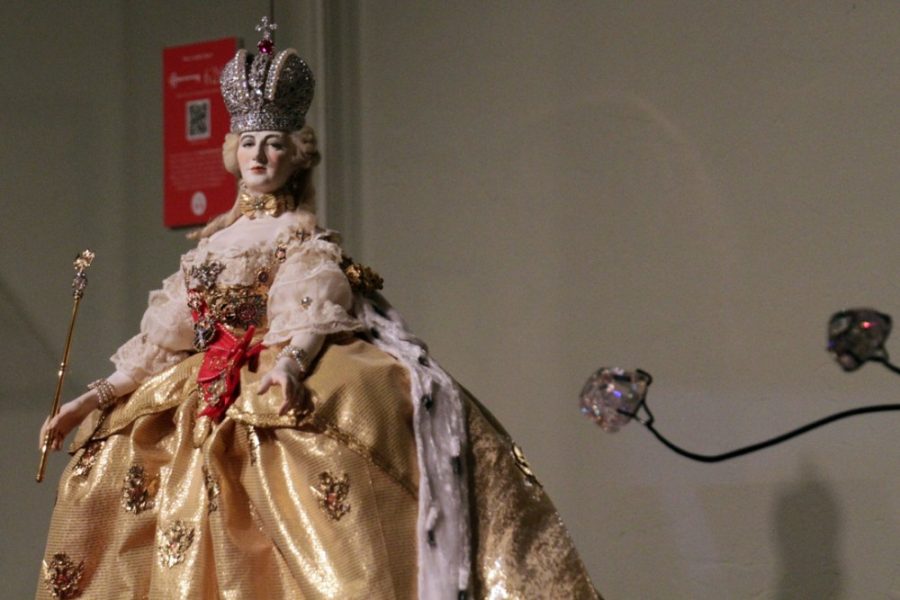An unconscious, drunken slob slouches in his embroidered chair, his golden chalice toppled onto the floor. He is overweight, overdressed, resplendent.
A one-quarter life-size figure of King Louis XVI, skillfully crafted by George Stuart, is just one of 18 historic figures currently featured in his exhibit at The Mini Time Machine Museum of Miniatures, titled “Diamonds are Forever: The Incredible Journeys of World-Famous Diamonds & the People Who Owned Them”.
The exhibit begins in the Golden Age of India, where each displayed diamond was mined before passing through the hands of history.
Louis XVI’s place in the collection is based on his status as one among few to claim possession of what is believed to be the Hope Diamond, currently stored in the Smithsonian National Museum of Natural History. Other famed diamond owners in the exhibit include Napoleon Bonaparte, Marie Antoinette, Marie de Midici, Frederic the Great, Prince Albert and Queen Victoria, all attired in replicas of their clothing.
Louis XVI’s lethargic pose is an example of Stuart taking artistic license to reflect the French monarch’s personality, adding a humorously unexpected, regal twist.
Scott Sucher recreated each diamond to coordinate with Stuart’s historic figures for the Museum of Ventura County. Each recreation is made from cubic zirconia after years of research into the evolving cut, quality, name and owner of each gem.
The cut and use of each diamond was altered according to a country’s preference. India preferred a flatter cut to showcase clarity and weight. An ostentatious size and style of diamonds were commonly associated with European tastes.
After cutting each recreation into the precise dimensions of the original, Sucher duplicates this process to scale the diamond down to one-quarter of the original size. The quarter-size replica is fastened into the jewelry, headpiece, scepter or clothing of the figures, depending on the evidence of how each used the diamond. To call these figures dolls understates the significant effort and research done to achieve the figures’ historical accuracy. Their handcrafted lace, metalwork and meticulous facial expressions truly make them into works of art.
“Each stone has a story giving its history and travels that it went through and the various hands that owned it, until its final resting place,” said Lisa Hastreiter-Lamb, the museum’s associate director and director of education.
One stone’s final resting place, the Koh-i-Noor diamond, is fastened to a crown in the Tower of London and is considered part of the British Crown Jewels. The Koh-i-Noor’s first known public appearance was before 1739 on the throne of Mogul Emperor Shah Jahan. Nearly 100 years later, the King of Afghanistan exchanged the Koh-i-Noor to the Sikh Empire in exchange for asylum from his warring country. Pakistan and India have repeatedly demanded that British monarchs return the diamond, to no avail.
Gentry Spronken, the museum’s director of marketing and communications, said The Mini Time Machine Museum of Miniatures was a personal passion project of founder Patricia Arnell. Arnell’s fascination for miniatures began in the 1930s and evolved into a collection. In the 1970s, Arnell looked for opportunities to showcase her personal collection and the artists and provide a unique educational experience. Arnell and her husband founded the museum as a hub of sensory exploration through history.
“In some cases, these diamonds are lost to history, so the only thing that exists is the replica,” said Hastreiter-Lamb, motioning toward the full-scale replica of the Mirror of Portugal diamond.
Arnell’s initial hope for a place to showcase history leaves visitors mulling over a particular question: Since humans responded to the diamonds with war, death, debt and greed, is it truly unfortunate that some gems are missing?
The “Diamonds are Forever” exhibit will be on display at the museum, Tuesday through Sunday, until April 19.
_______________
Follow Anna Mae Ludlum on Twitter.









